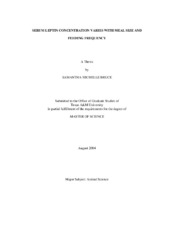| dc.description.abstract | Horses with high energy requirements are generally fed two large concentrate meals per day, either in the form of grain or pellets. The postprandial elevation of blood glucose resulting from this type of feeding has the potential to alter production of hormones such as leptin. Leptin is an adipose-derived protein that promotes satiety in normal animals. The objective of this study was to determine if feeding large amounts of concentrate twice each day would alter serum leptin concentration. Nine horses were placed into three groups (A, B, and C) and each group was rotated through three feeding schedules (2x, 3x, and 4x) in a 3 x 3 Latin square design. Horses were fed twice per day on the 2x schedule, three times per day on the 3x schedule, and four times per day on the 4x schedule. Horses were fed the same total amount of concentrate per day throughout the study, although meal size varied with the number of times the horse was fed per day. Horses were weighed and scored for body condition on the first day of each period. Each treatment period lasted for 11 days. Blood was drawn on days one, four, and seven of each period and leptin concentration was determined by radioimmunoassay. On the afternoon of the tenth day of each period, horses were fitted with jugular catheters and blood was drawn every two hours for 24-hours to determine the circadian rhythm of leptin secretion. Additionally, blood was taken 30 minutes prior to and every 30 minutes after the morning meal to determine postprandial plasma glucose concentrations. Mean and peak glucose values were higher on the 2x schedule than the 3x or 4x schedules (P < 0.05). Leptin concentration was highest in horses on the 3x schedule, although when these data were normalized to baseline (day one) values, leptin was highest on the 2x schedule (P < 0.05). Serum leptin concentration was highly correlated with body condition score (P < 0.01), but not gender (P = 0.82), and leptin increased throughout the study (P < 0.05). Data from the 24-hour collection showed that serum leptin concentration varied with time in horses on the 2x but not the 4x schedule (P < 0.05). Linear regression of data from the 2x schedule indicates that the pattern of change may be modeled by a quadratic equation (P < 0.05). This study demonstrates that feeding horses large carbohydrate meals twice per day disrupts the normal pattern of leptin in the horse, possibly affecting appetite and other physiological processes. | en |


